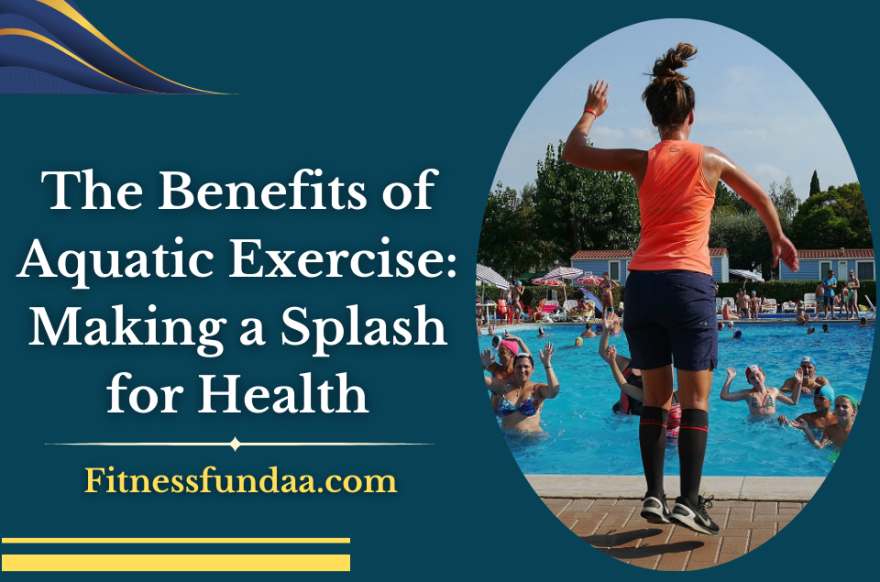Aquatic exercise involves physical activities performed in water, capitalizing on water’s buoyancy and resistance for a comprehensive workout. Buoyancy reduces joint impact, making it ideal for individuals with arthritis or recovering from injuries, while water resistance enhances muscle strength. Its popularity spans diverse age groups and fitness levels due to inclusivity and adaptability. Suitable for all ages, aquatic exercise is widely recommended for rehabilitation and embraced by those seeking low-impact fitness options.
Water aerobics classes provide a social workout environment, and its therapeutic effects attract individuals looking for stress relief. Overall, aquatic exercise’s versatility and health benefits contribute to its widespread popularity in fitness communities. In this article we’ll explore the benefits of aquatic exercises.
Unique Characteristics of Water:
Buoyancy: A Friend to Achy Joints in the Water
Ever notice how water feels like a relief for those creaky joints? Well, it’s all thanks to buoyancy, that cool property of water that makes it the superhero for folks dealing with joint issues or arthritis during aquatic workouts. When you’re in the water, it’s like you’re getting a break from gravity’s tough love. The water helps lift you up, taking some of the weight off your joints. It’s like your joints are getting a gentle hug, making movements easier and way less painful. So, if you’re someone who’s been dealing with joint troubles, diving into aquatic exercise might just be the cozy, joint-friendly activity you’ve been searching for – a bit like giving your joints a vacation from the usual wear and tear.
Resistance: Harnessing Water’s Inherent Challenge:
The inherent resistance of water is a foundational element contributing to the efficacy of aquatic exercise in bolstering muscle strength and endurance. In contrast to land-based exercises relying on gravity or external weights, water offers resistance from all directions. As individuals move through the water, they encounter resistance from water molecules, necessitating increased muscle engagement.
This consistent resistance activates multiple muscle groups simultaneously, resulting in progressive improvements in strength and endurance. The adaptability of water resistance allows for customized workouts suitable for individuals at various fitness levels. Whether through swimming or water aerobics, the innate resistance of water creates a demanding yet joint-friendly environment, fostering the development and toning of muscles.
Physical Health Benefits:
Joint-Friendly Workout:
Leading on a fitness journey tailored for joint health feels like a refreshing breeze for those grappling with arthritis or joint issues. Opting for low-impact exercises, such as swimming or cycling, provides a gentler alternative by minimizing stress on knees, hips, and the spine. Picture the soothing embrace of water during a swim, where buoyancy acts as a natural cushion, making exercise not just therapeutic but joint-friendly.
Yet, it’s not just about being gentle; it’s also about embracing fluid movements that boost flexibility. Stretching exercises, dynamic stretches, and yoga become daily rituals, unfolding like a choreographed dance that improves joint mobility. It’s akin to providing joints with a daily spa treatment, ensuring they remain well-lubricated and agile.
The procedure extends to strengthening exercises, building a protective shield around joints. This newfound strength offers stability, like a reliable frame supporting overall joint function. The result? A noticeable shift in the experience of pain, as deliberate movements, flexibility, and muscle support converge to bring relief.
Beyond immediate benefits, this journey becomes an investment in long-term joint health. These exercises aren’t just about the present; they’re about preserving joint vitality for years to come. The narrative evolves into a celebration of simplicity—reaching, bending, and walking without the hindrance of joint pain. It’s a story of empowerment, where tailored exercises become chapters in a tale of resilience, well-being, and the joy of a body that, despite challenges, continues to move and thrive.
Cardiovascular Fitness:
Dive into the world of aquatic fitness, where the natural resistance of water transforms exercise into a cardiovascular symphony. Whether it’s swimming or water aerobics, the resistance challenges various muscle groups, demanding continuous effort and elevating the heart rate. This dynamic engagement not only strengthens the heart muscle but also enhances overall circulation.
The beauty of water workouts lies in their accessibility, offering a joint-friendly option for individuals with varying fitness levels. It’s a holistic approach to cardiovascular fitness, where the fluid resistance of water becomes a catalyst for endurance, heart health, and a fulfilling exercise experience.
Muscle Strength and Endurance:
Water resistance in aquatic exercises is a transformative force, challenging muscles and fostering strength and endurance. Moving through water requires muscles to work harder, gradually leading to increased strength. What makes aquatic exercises unique is their targeted engagement of specific muscle groups, varying based on movements.
Whether it’s the arms pushing through water during swimming or the legs kicking, muscles experience continuous and multidirectional resistance, promoting endurance throughout the full range of motion. This dual impact of strength and endurance makes water-based workouts not only effective but also accessible and adaptable for individuals of varying fitness levels.
Calorie Burning and Weight Management:
Step into the aquatic realm, where the art of calorie-burning takes on a dynamic form, making it an irresistible choice for those on a quest for weight management. Here, the water becomes a resistance force, turning every swim stroke and water aerobics move into a calorie-incinerating spectacle. The fluid resistance demands more energy, amplifying the calorie expenditure and transforming water into a weight-loss ally.
What makes the aquatic arena even more enchanting is its gentle touch on joints. The buoyancy of water provides a cushioning effect, granting the freedom for extended and frequent workouts without the fear of joint strain. This not only opens the door for individuals with joint concerns but also establishes a foundation for a consistent exercise routine—a vital ingredient in the recipe for successful weight loss.
In this aqueous world, the allure doesn’t stop at calorie burn; it extends to a harmonious blend of cardiovascular and strength training exercises. Each aquatic move not only torches calories in the moment but also ignites the metabolic flame, ensuring that the body continues to burn calories even after the water session concludes. This post-exercise calorie dance adds an extra layer of efficacy to the weight management narrative.
The charm of aquatic exercise in the weight loss story lies not just in its effectiveness but in the sheer joy it brings. It offers a departure from the conventional, making fitness an immersive and enjoyable experience. In essence, the aquatic journey unfolds as a holistic and efficient expedition, beckoning individuals to immerse themselves in the fluid realm for a refreshing approach to weight management and an overall rejuvenation of well-being.
In summary, aquatic exercise stands out as a flexible and all-encompassing fitness option, leveraging the distinct attributes of water to facilitate workouts that are gentle on the joints, improve cardiovascular well-being, and cultivate muscle strength and stamina.
Its versatility renders it appropriate for people of various ages and fitness capacities, providing rehabilitative advantages for individuals grappling with joint concerns and gaining traction as a favored alternative for weight control. The story of aquatic exercise is one marked by empowerment, tenacity, and comprehensive health, rendering it a revitalizing and pleasurable method for those in search of a well-rounded and enduring approach to their lifestyle.
FAQs Answered
What makes water a unique environment for effective workouts?
Water’s buoyancy and resistance create a joint-friendly workout space, promoting both muscle strength and endurance in a comprehensive manner.
How does water resistance contribute to muscle engagement in aquatic exercises?
Water resistance activates muscles comprehensively, requiring increased effort in all movements, leading to gradual improvements in both strength and endurance.
How does aquatic exercise contribute to weight management and calorie burning?
The resistance of water turns aquatic exercise into an efficient calorie-burning activity, making it valuable for weight management.
What equipment is needed for aquatic exercise, and is it expensive?
Minimal equipment like swimwear and water shoes is needed, and additional equipment is not necessary for a cost-effective aquatic exercise routine.
Is there any age limit for starting aquatic exercise?
No, aquatic exercise is favourable for individuals of all ages, creating a lifelong commitment to health and fitness.

